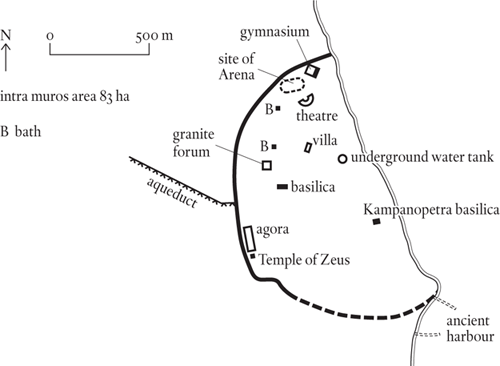
Cyprus
Legend tells that at the end of the Trojan War, a prince named Teukros from the Greek island of Salamis founded a new city with the same name on the east coast of Cyprus. Archaeology suggests that the city of Salamis was founded around 1075 BC by inhabitants of the nearby town of Enkomi after it was damaged by an earthquake. Cyprus was an important place for Bronze Age traders, in part due to its productive copper mines.

Salamis featured a temple of Zeus, who remained the city’s patron deity down to Roman times. The city also had an excellent natural harbour, which helped facilitate its success as a centre for international trade. In 707 BC, Cyprus agreed to submit to Sargon II, the king of Assyria. Rich tombs from that period indicate that the local kings of Salamis enjoyed sufficient autonomy to accumulate substantial wealth. In the seventh century BC, Salamis was one of the largest and richest cities in the Eastern Mediterranean. The Salaminians traded actively with Greece, Asia Minor, RHODES and Egypt. Their products included bronzes, ivories, painted vases and limestone statuettes.
In 669 BC, following the collapse of the Assyrian Empire, Cyprus fell increasingly under the influence of Egypt. By 570 BC, the Egyptian king Amasis had become effective ruler of the island. Chafing under Egyptian control, however, the Cypriots were willing to switch masters and submit to Cyrus the Persian in 545 BC. By 521 BC, Cyprus became part of the Fifth Persian Satrapy. It seems, however, that the locals came to dislike Persian rule as much as that of the Egyptians. Under Darius I (521–486 BC), a member of the Salaminian royal family named Onesilos led a revolt that attracted support from Greece. When Onesilos was killed, the Greeks withdrew their fleet and Persian rule was reinforced. In 480 BC Xerxes I led a Persian army against Greece, and Cyprus was obliged to send 150 ships to assist the campaign.
In 459–458 BC, the Greeks again sent a fleet for the purpose of liberating Cyprus from Persia. After suffering defeat in Egypt, however, the Greeks withdrew. Again in 449 BC, the Greeks attempted unsuccessfully to conquer Salamis, but they ended up signing the Treaty of Kallias, which left the Persians in control. Under King Evagoras I (410–374 BC), the city enjoyed a Hellenic revival, although he also was ultimately compelled to submit to Persia.
The kings of Cyprus sent ships to support the campaign of Alexander the Great, whose victory freed Cyprus from Persian domination. Upon Alexander’s death in 323 BC, Cyprus was disputed between his successors, Antigonus and Ptolemy. Salamis sided with Ptolemy, who sent his brother Menelaos to seize the island. After initial success, Demetrius (son of Antigonus) arrived to besiege Menelaos in Salamis. Even though Ptolemy sent a fleet of ships to assist his son, Demetrius used catapults and various other inventive weapons to prevail in his siege. Demetrius thereafter ruled at Salamis successfully for twelve years. When he was away in Cilicia in 294 BC, however, Ptolemy arrived with a fleet and captured Salamis after a short siege.
Thereafter, the Ptolemies of Egypt ruled Salamis and the rest of Cyprus until it became a Roman province, under Marcus Porcius Cato, in 58 BC. As an example of the balanced Ptolemaic administration, the highest official had the title of strategos, while the official in charge of the copper mines was the antistrategos. Salamis remained a large prosperous city, minting its own coinage. After being handed back briefly to the Ptolemies in 47 BC, Cyprus resumed its Roman status in 30 BC after the Battle of Actium. At that point, the Roman capital city shifted from Salamis to Paphos, which was restored by Augustus and referred to as Sebaste Augusta.
Although no longer the political capital, Salamis remained the largest city on Cyprus in Roman times. It attracted a large international population, including many Jews. St Paul and St Barnabas (a Cypriot) founded a Christian community there. Meanwhile, the emperor Augustus sponsored construction of a large gymnasium and a theatre that could hold 15,000 spectators. The city also boasted an amphitheatre and stadium. Excavations have uncovered a large reservoir for water that came into the city through a 48-kilometre (30-mile) aqueduct.
In the reign of Trajan, a large segment of the population died or was dispersed during the unsuccessful Jewish revolt of AD 116. The city is unlikely ever to have regained its previous population, which the archaeologist Vassos Karageorghis has (excessively) estimated in the range of 350,000.
In AD 332 and 342, Salamis suffered substantial damage from earthquakes. During the reign of Constantius II (337–61), the city was granted four years’ exemption from imperial taxes in order to concentrate on reconstruction. The citizens expressed their gratitude by renaming their city Constantia, and under that name it served as an episcopal see. Salamis gradually declined as its harbour silted in, however, and was finally abandoned during the seventh-century Arab invasions, after which the remaining inhabitants moved to Famagusta.